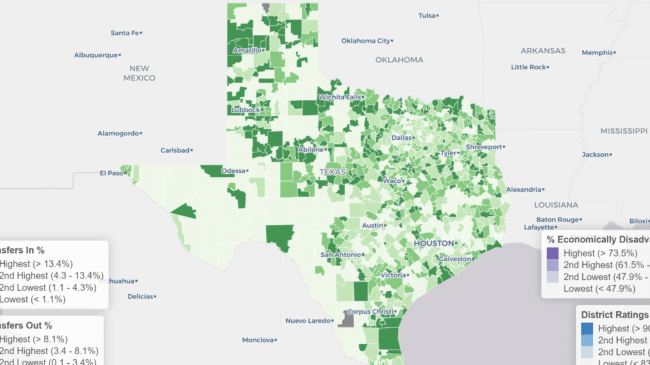Open enrollment policies provide educational opportunities for families by allowing students to enroll in a public school outside of their residentially assigned school district. The needs of every student are different and providing more educational options ensures that students can be successful. Yet, little is known about open enrollment in most states despite the fact that research shows it provides positive benefits for families.
In cooperation with the Texas Public Policy Foundation, Reason Foundation has created the Texas Student Transfer Dashboard to shine a light on open enrollment trends in the state. The interactive tool below maps the 2018-2019 student transfer data for every public school district in Texas. It also provides charts that show these trends by school district ratings and school district student demographics.
There are two types of open enrollment: Intradistrict refers to transfers within a child’s home school district, while interdistrict refers to transfers outside of a child’s home district. The subject of this research is exclusively on interdistrict open enrollment.
Our analysis finds that three percent of Texas students transferred to a traditional public school outside of their assigned school district in the 2018-2019 school year.
Importantly, these students tended to transfer to higher-performing school districts as measured by state accountability grades. In 2018-2019, roughly 45,000 Texas students transferred to a higher-performing school district at least a letter grade above their residentially assigned district.
We also find that students tend to leave lower-income school districts at greater rates than higher-income school districts, although it’s not possible to determine the demographics of these students due to lack of state and school district reporting policies.
Additionally, we observed that Texas school districts accept transfer students at varying rates, with some school districts enrolling thousands of students from outside of their boundaries and others enrolling none at all. Because the state does not report school district transfer policies it is difficult to know how widespread transfer opportunities are and whether additional seats are available for students.
It is clear though that there are substantial policy barriers to ensuring that all of Texas’ students have access to robust open enrollment opportunities. These include inadequate protections for families, opaque transfer processes, as well as limited support for transportation outside of a student’s residentially-assigned school district.
There is also a real need for increased transparency and reporting on open enrollment at the state level. While Texas’ open enrollment data is vastly better than most states, it still falls well short of providing stakeholders with the information they need to make sound policy decisions. Because of this, it is impossible to determine the demographics of transfer students, their reasons for transferring, or even the schools they are leaving from and going to. Steps should be taken to ensure these and other data—including school districts’ transfer policies—are collected and reported regularly.
The interactive tool below allows users to see which school districts in Texas have the highest rates of student transfers. The tool also shows how student demographics and district performance impact transfer trends. The full dashboard is also available here.


